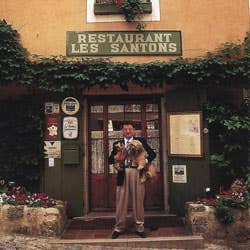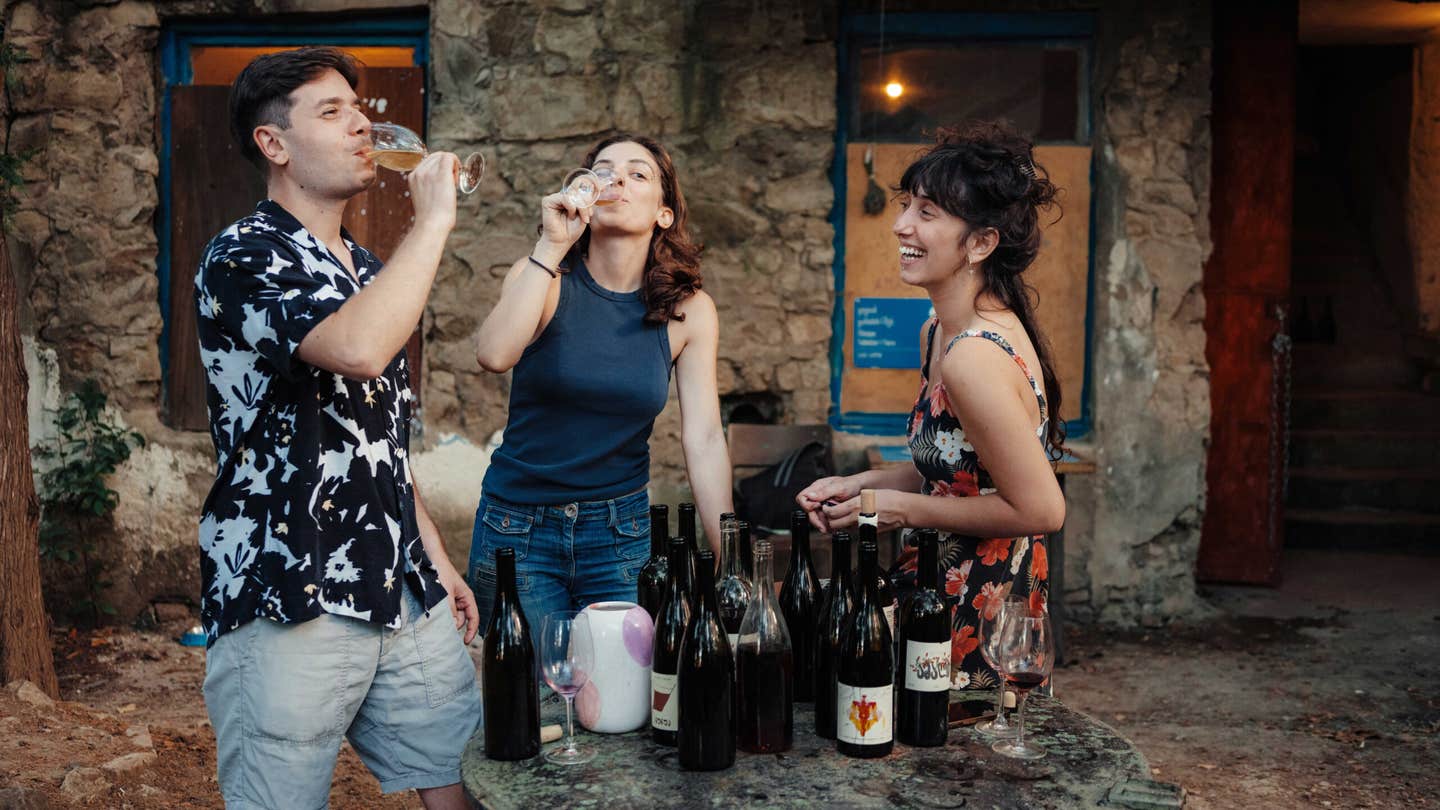
Hidden Provence
_Far from the beach resorts and lush gardens for which the South of France is famous, this beautiful but harshly rugged region retains the old Provençal values of simplicity and frugality—and cooks hearty, honest dishes full of the flavor of the land.
_
Everybody knows Provence—the lush orchards and vegetable gardens of the lower Rhone Valley, the generous vineyards of Tavel and Chateauneuf-du-Pape, the sophisticated beaches and palm-lined avenues, the stands of plane trees and mimosa forests.
But there is another Provence, hidden from the casual traveler, far from the lively capitals of Avignon, Aix-en-Provence, Arles, Marseille, and Nice. This is the region known as Haute Provence—officially the Departement des Alpes-de-Haute-Provence—northeast of Marseille, northwest of Nice, one corner touching the Italian border on the edge of Piedmont, another abutting the Vaucluse (which is itself opulent Provence, and everything that Haute Provence is not). In Haute Provence, you will look in vain for hillsides covered with vacation villas, for pretentious shops and galleries, for Souleiado-wrapped resort hotels.
Real people live in Haute Provence, in real towns and real countryside. The land is rugged and the winters are hard, borne on insolent raw winds. In spring, riverbeds rage with fierce torrents fueled by melted snow and violent rains; in summertime, they turn dry and stony. The soil is not fertile. Over the centuries, farmers here have built narrow terraces on steep hillsides, just wide enough to plant a few vegetables, a few thin rows of trees and vines—barely enough for sustenance. The rocky plains, vast flat spaces, are scarcely more hospitable, yielding just enough shrubbery and wild herbs to feed a few goats, lambs, and rabbits. Yet in this sober place, Homo Provencalus has remained solidly anchored to the land, to family and tradition—enduring, like his most familiar allies, the olive tree and the vine, because his roots are deep.
And there are other virtues in this little-known Provence. The sky is at its bluest, the air its purest. At night, there seem to be more stars here than anywhere else in France. (From the Observatoire de Haute-Provence, near the attractive hillside town of Forcalquier, one can read the sky like an open book.) In spring and summer, the fields are alive with fragrant rosemary, wild thyme, savory, juniper bushes, a whole bouquet of blue and pink alpine flowers. Medicinal herbs, still used often in the region as home remedies, seem to grow by the side of every road in the upper regions—gentian, hyssop, mallow. There are three kinds of lavender, stretching across the plains in luminescent clumps, gigantic sunflowers, golden brushes of genista or broom, and bright bitter almond trees.
One great surprise in Haute Provence, in this otherwise hard land, are its waters—most of all the rivers of the Durance and Verdon, and the sprawling lake of Sainte-Croix. In this dry territory, water has a magical quality, and coming suddenly upon a fast-coursing river or an immense expanse of placid lake can seem literally thrilling. The road running alongside the Verdon, through the Gorges du Verdon, is among the most dramatic drives in Europe. High, pale, lilac-colored rock rises up hundreds of feet above the river, sometimes so passionately upthrust that it seems to be still moving upward.
The food in Haute Provence, like the people, has character. It is born of a respect for the land and for the collective memory of the region. The most celebrated local ingredients—the sweet lamb of Sisteron, the chestnut leaf-wrapped cheese of Banon, the lavender and wild herb honey made in the area—are fashioned slowly, given time to mature into their glorious selves.
Though this region, unlike other parts of Provence, has little commercial olive oil production (there are only two oil cooperatives and four small, privately owned mills in the entire departement), the olive tree is perhaps the ideal metaphor for Haute Provence. It is as thrifty, modest, and hardworking as the people whose needs it serves. It is a tree that doesn't ask for much—just meager soil and a little rain—yet it generously provides a great deal in return. It shelters the land with a delicate year-round shade that protects plants growing beneath its foliage. Olive oil, of course, is basic to Provençal cuisine, and is still valued for its cosmetic properties. An herb tea made from its sprouts is said to fight high blood pressure. Trimmed twigs and branches are carved into useful implements or burned for cooking fuel. And of course the olive tree's fruit, when cured, is splendid food, delicious by itself and a welcome enrichment to many simple dishes.
Simplicity, in fact, is the defining quality of the cooking of Haute Provence. A splash of olive oil, some juniper berries, a sprig of thyme, a sprinkle of chopped mint—these are the guileless "tricks" by which a rustic vegetable soup, a simple broiled fish, a plain leg of lamb are transformed into splendid fare. Herbs are found in almost every dish, but they are used discreetly, and are evocative rather than overwhelming. The one luxury product found here, though not in the abundance of earlier days, is the black truffle—hidden under oak or hazelnut trees to be sniffed out by specially trained pigs or dogs. After a successful day of digging, the hunting party might share a small part of the harvest—raw, thinly sliced, and lightly salted—placed on top of thick slices of toasted local bread. In winter (truffle season), even modest local eating places serve truffle omelettes or potatoes cooked with the black jewels.
Local pork products are ubiquitous—not just mountain ham, but dried sausages and caillettes (ground-pork patties flavored with herbs), all typically served with bitter olives and fougasse, that flat, lacy, wood-oven bread rich with olive oil. Pasta, made at home with chives, parsley, mint, even spinach in the dough, is graced with sheep's or goat cheese and a drop of olive oil. The lean and fragrant lamb of Sisteron—considered by French gastronomes to be among the best in France—might be presented simply roasted with thyme-flavored potatoes and with bright green new asparagus.
Rabbit, cheap and popular, is sometimes roasted with olive oil and herbs, too, with olive oil and herbs; sometimes braised in red wine. Daube, the long-cooked stew made elsewhere in Provence with beef, might be made here with game, say wild deer or boar, which in these precincts aren't some "gourmet" luxury, but rather the bounty of the land, free to anyone who can take them.
Though modern-day transportation delivers fresh Mediterranean and even Atlantic seafood to the tables of the region's better restaurants, the fish most commonly consumed here is usually trout from local lakes and rivers. Salt cod, that staple of "poor" cuisines all over southern Europe, is likely in Haute Provence to be the centerpiece of the Grand Aioli, where it joins an assortment of boiled vegetables served with pungent garlic mayonnaise. Vegetables often make a meal—especially the impeccably fresh and flavorful "primeurs", or first spring vegetables, like young artichokes, asparagus, early garden peas, fennel, and fava beans. For dessert, there might be toasted almonds, orange-blossom cookies, honey-flavored quinces baked in bread dough, jam tarts filled with homemade preserves. The food of Haute Provence reflects the world around it, and is of that world.
Getting to know that world intimately is not easy, but catching at least a glimpse of its rough-hewn beauty is. No more than a few hours by car from the Cote d'Azur or the better-known regions of inland Provence, the departement is crisscrossed with roads that are tortuous but uncrowded. In a single day, the determined visitor could see the region's pleasant capital of Digne-les-Bains, the rocky fastness of Sisteron, the appealing hill town of Forcalquier, the picturesque agricultural center of Manosque. Another day could be devoted to the smaller villages in the heart of Haute Provence. The medieval town of Greoux-les-Bains, nestled on a hillside above the Valensole plateau, is particularly appealing. Here, 16th- and 17th-century stone houses set on winding streets overlook oceans of lavender in summer, orchards alive with pink and white blossoms in the spring.
The town's thermal spa, with its warm, bubbly sulfurous waters, has been enjoyed by curistes since Roman times. Northeast of Greoux, a little road running along the Gorges de Colostre, with its startling red rock walls, leads to the handsome villages of Saint Martin-de-Brome and Allemagne-en-Provence. Beyond Allemagne is the town of Riez, sometimes said to be the oldest in Provence. Just outside the town are four gray granite columns standing in a field—all that remains of a Roman temple to Apollo that once stood here. The village is a maze of narrow streets and covered passages, lined with stone-faced houses tightly bunched together.
The jewel of this part of Haute Provence, though, is certainly Moustiers-Sainte-Marie. Built against a rock wall on the side of a gorge, this tiny village is cut in half by a mountain torrent and linked by a bridge. Across one gap in the rock is a wrought-iron chain holding a star, said to have been given to the village by a Provençal nobleman to fulfill a vow made during the Crusades.
Moustiers is famous all over France and beyond for its unique ceramics. In gastronomic circles, it is known for a restaurant called Les Santons. Santons are Provençal folk-art figures, originally meant to populate the Christmas creche but now valued and displayed throughout the year. Both santons and Moustiers ceramics decorate the restaurant's tiny dining rooms, which are bright and flower-filled, with fine white napery, gold-framed paintings, and old wood beams. Opened in 1981 by Andre Abert, a former maitre-d'hotel at Maxim's in Paris (and the son of a Moustiers schoolteacher) and his partner Claude Fichot, a restaurateur from Montpellier, Les Santons has earned a star in the Guide Michelin for its refined interpretations of local dishes. Refined doesn't mean precious, though. A "petit ailloli" (the Provençal spelling of aioli), in which the traditional salt cod is replaced with a terrine of sole, salmon, and baby vegetables, comes with an assertive garlic sauce that would be at home on any rustic table. Farm-raised chicken is roasted and served with a sauce that seems to involve a whole bouquet of just-picked herbs, sweetened with a touch of lavender honey. Lavender scents the ice cream, too, that accompanies an intensely sweet local pear enrobed in brioche pastry.
Even in fancified form, the flavors of Haute Provence endure.
Keep Reading
Continue to Next Story










